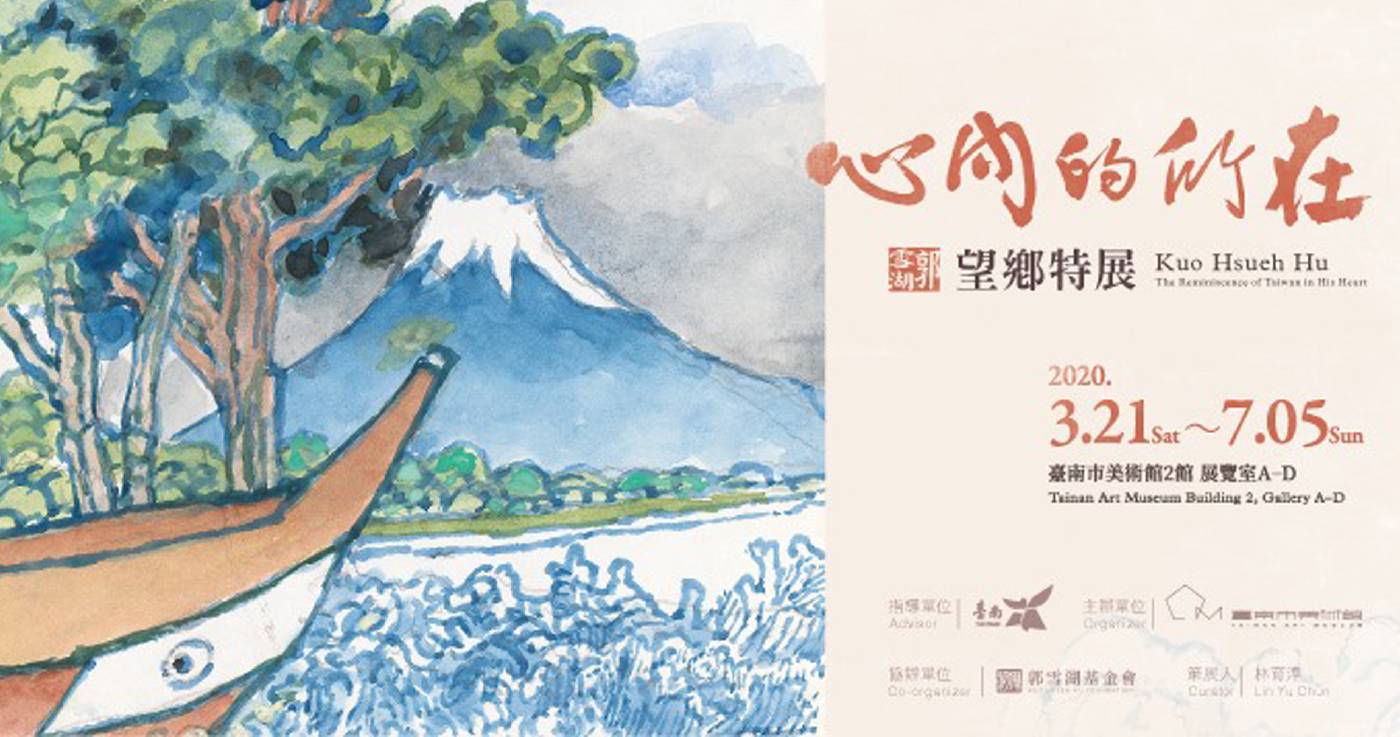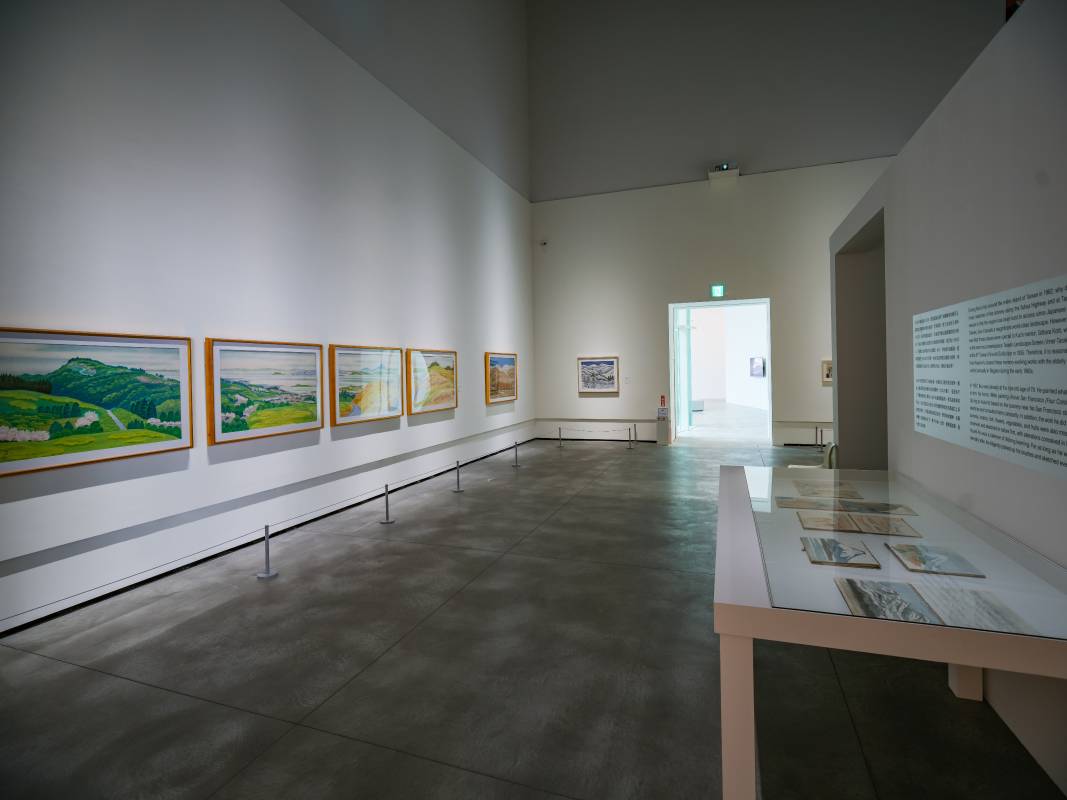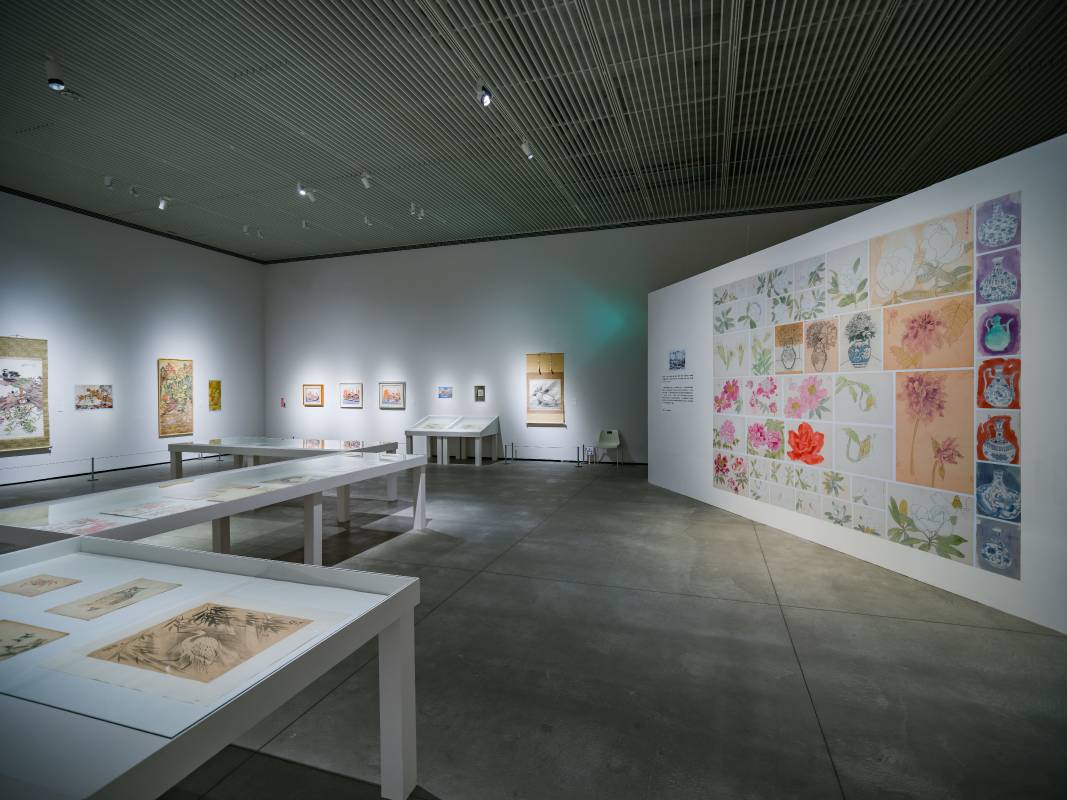臺南市立美術館
【心內的所在--郭雪湖望鄉特展】

-
展期
日期:2020-03-21 ~ 2020-07-05
-
地點
中西區忠義路二段 1 號(2館1樓展覽室A、2館1樓展覽室B、2館1樓展覽室C、2館1樓展覽室D)
-
參展藝術家
郭雪湖
-
郭雪湖(1908-2012)生於臺北大稻埕,1917年就讀日新公學校,3年級因導師陳英聲的啟蒙而開始水墨及水彩技法的練習,日新公學校畢業後,考入台北州立工業學校,因興趣不合毅然退學,1924年進入大稻埕蔡雪溪畫館拜師,藝名為雪湖,不到一年時間,靈巧的郭雪湖離開師門自立門戶,開始了職業畫家的生涯。
以繪畫為業的郭雪湖對於藝術生涯一直兢兢業業,自1927年與陳進、林玉山等人以20歲青年才俊之姿入選台展之後,整個日治時期共16屆的台、府展,郭雪湖不曾缺席,而且獲得特選、台展賞、晉昇無鑑查,資歷極為完整。
明於世事、眼光精準的郭雪湖,日治時期悉心跟隨恩師鄉原古統,並且加入「栴檀社」、「六硯會」等重要集會,另外也曾參加「臺陽美展」東洋畫部。戰後初期他受聘為長官公署諮議,並與楊三郎等人籌組「臺灣省全省美術展覽會」(省展),另外也擔任「台灣全省學生美術展覽會」審查委員及「臺灣全省教員美術展覽會」顧問,他更創辦了全臺第一所經由教育局正式立案通過的「雪湖美術教室」。1964年郭雪湖離臺移居日本,之後的歲月更遍歷泰國、菲律賓、印度、中國大陸、美國等地,完成許多系列創作,郭雪湖堪稱自學成功的範例,故鄉的所在更是他魂牽夢縈的處所,也觸動源源不絕的創作能量。
「歷史」源自「記憶」。由於人們對故鄉的關愛,因此,一旦故鄉空間(space)富含人們生活經驗、情感及認同(identity),「空間」即轉化為具有獨特性的地方(place)--即閩南語所稱的「所在」。值此記憶研究(memory study)蔚為學術風潮之際,在時間長河中從事「記憶溯溪」,不但可以關照地方書寫(the fabrication of place),更能將「咱的所在」豐富多元的在地故事傳承永續。
「心內的所在 / 郭雪湖望鄉特展」是臺南市美術館為建構臺灣美術史所規畫的系列展覽之一。起點是從郭松年先生新近為其父郭雪湖所出版回憶錄「望鄉」一書開始發想,聚焦於探究郭雪湖多年於海內、外深耕累積的多元性及國際化觀點,並從一個旅人的創作視角,回望故鄉所在的內心歷程。過程中關注於藝術家行走於臺灣、日本、美國、中國等幾個國度與城市之間的深刻對話。特別是青年時期的臺北大稻埕、壯年時期的臺南府城的作品,更是此次展覽的重點。晚年生活在異鄉的郭雪湖,依然掛念童年時期大稻埕的黃金歲月,於舊金山的望海山莊一探窗外,誤認舊金山成了老家的觀音山。此時藝術家對故鄉的回望及思念,喚起觀眾一窺當年郭雪湖所經歷的歷史現場。
臺南市美術館作為21世紀臺灣第一座深耕在地的國際級美術館,位於具有400年以上文化瑰寶的歷史古都,對於郭雪湖在故鄉臺灣城市中的創作旅程中,是非常重要的據點,也因此作品中呈現了許多臺南古蹟的風景繪畫。相比過去郭雪湖回顧展中所呈現,本次更聚焦在藝術家個人濃烈的故鄉情懷,以及人文風景繪畫的特殊觀點,在其走訪城市寫生的記憶中,為我們留下了深刻的歷史研究重點,以及文化傳承的重要根源。
本展展間中分區展示郭雪湖手稿、繪畫原作、文獻資料,以及邀請VR、AR、動畫團隊製作數位科技作品,讓觀眾親身體驗20世紀初的郭雪湖畫室、大稻埕南街、圓山附近、城隍廟、觀音山、淡水河、基隆河交界、以及臺南府城諸多風土民情、美國舊金山晚年住居附近所見,這個展覽嘗試以多元展示手法,探索郭雪湖內心的真實「所在」,儘可能重建當年的歷史現場。透過作品真跡與影像數位動畫間的相互搭配展示,為不同世代的觀眾群,創造別具意義的互動閱覽途徑,善用歷史記憶將是建立更美好未來的重要憑藉,而更為重要的,則是我們當下對於過往文化資產及前人創作能量的重新理解。
Born in Tuā-Tiū-Tiânn, Taipei, Kuo Hsueh-Hu (pronounced as Kueh Suat-ôo in Taiwanese,1908-2012) is known as one of the most important pioneering painters in colonial Taiwan. He was enrolled in Rihsin Public School (Kōgakkō) in 1917, mainly for local Taiwanese rather than Japanese students who were allowed in Primary School (Shōgakkō), and was introduced to ink wash and watercolor painting techniques by his homeroom teacher Tân Ing-siann when he was a third grader. After graduating from Rihsin Public School, Kuo was admitted to Taipei State Industrial College but soon found his interest elsewhere and decided to drop out. He later became an apprentice at Tshuà Suat-Khe Painting Studio in Tuā-Tiū-Tiânn, and was given the artist name ¨Suat-ôo¨ (Hsueh-Hu). Less than a year, the clever and talented Kuo built himself a new path away from the painting studio and his master to start a career as a professional painter.
Making painting his lifetime devotion, Kuo was known to be a disciplined and persistent artist. Since his name first appeared in Taiwan Exhibition in 1927 (along with Lin Yu-Shan and Chen Chin, all in their twenties), Kuo had never missed an edition for 16 years till the end of the Japanese Occupation, where he was granted with Special Selection Prizes, Taiwan Exhibition Prizes, and eventually direct-entry status.
With an artist vision full of insights and comprehensive wisdom, Kuo – the then diligent student of the Japanese artist Kuohara Kotou in colonial Taiwan – subsequently joined Chinaberry Society and Six Ink stone Society, while he was also a member of Tai-Yang Art Exhibition (Japanese painting section). Right after the end of the war, Kuo was appointed a consultant to the government and organized the Taiwan Provincial Fine Art Exhibition (also known as the Provincial Exhibition) with Yang San-Lang and other fellow artists. His other titles during this period included the jury member of Taiwan Provincial Art Exhibition for Students and the consultant to Taiwan Provincial Art Exhibition for Faculty. His “Hsueh-Hu Art Studio” was Taiwan’s first Education Bureau-registered art studio. Kuo left Taiwan to start a new life in Japan in 1964, followed by several journeys to Thailand, the Philippines, India, China, the USA, and so on, as depicted in his diverse paintings. He was a self-taught artist whose story inspired all, and his inspiration indeed came from the native land as the nostalgic sentiments were transformed into an uninterrupted flow of artistic expression.
“History” originates with “memory.” Our love for the native space, which is a place impregnated with people’s life experiences, sentiments, and identity, may turn this “space” into a distinguished place, the so-called “sóo-tsāi” in Taiwanese (literally “as it is”). Just as “memory studies” increases its academic visibility, the practice of “memory trekking” in the ever-moving stream of time not only effects the fabrication of place but is also able to carry on the rich and never-ending stories of our native land, the “sóo-tsāi” as it is.
‘Kuo Hsueh-Hu: The Reminiscence of Taiwan in His Heart’ is one of Tainan Art Museum’s feature exhibitions to construct the art history of Taiwan. The project can be traced back to Home Gazing: My Father Kuo Hsueh-Hu's Life in Art, the biography published by Mr. Kuo Sung-Nien in memory of his father. Following the memoir, the exhibition will offer a pluralistic and global perspective to examine Kuo’s domestic and international artistic achievements over the years, allowing viewers to imagine the artist as a home-gazing wanderer whose journey is both external and internal. It emphasizes the thought-provoking dialogue among the cities in Taiwan, Japan, the USA, and China as visited by the artist, particularly highlighted by the works created during Kuo’s youth in Tuā-Tiū-Tiânn and his prime years in downtown Tainan. Kuo spent the last years of his life in the foreign land, but his heart still lingered about the golden age of his childhood Tuā-Tiū-Tiânn, sometimes even mistaking the mountain view from his sea sight mansion in San Francisco as the Guanyin Mountain from his hometown. The nostalgia of the home-gazing artist, as seen in his memory-evoking paintings, indeed brings us back to the historic scenes where he had once experienced and lived.
As the first art museum dedicated to local culture on an international level in the 21st-Century Taiwan, Tainan Art Museum is built upon the cultural heritage of a city with an over-four-hundred-year history. In fact, it was also in this city, among the many places he had stayed, that Kuo further established his artistic career, while the historic sites and landscape of Tainan thus constituted a major body of his works. Unlike the previous retrospective exhibitions in honor of Kuo Hsueh-ho, ‘Kuo Hsueh-Hu: The Reminiscence of Taiwan in His Heart’ will focus on the artist’s deep yearning for his native land as it presents a unique humanity-oriented perspective of his landscape paintings. The memory of his journey from one city to the next are turned into vivid images, leaving us with an engraved point of entry for history studies as well as a hearth for cultural inheritance.
The exhibition includes several different sections presenting Kuo’s sketches, original painting, and historic documents, while it also features digital projects by VR, AR, and animation production teams to create a physical experience for viewers to travel from Kuo’s painting studio in the earth 20th Century, the South Street in Tuā-Tiū-Tiânn, the Yuanshan area, City God Temple, Guanyin Mountain, Tamsui River, the merging Keelung River, the flourishing folklife of downtown Tainan, and finally to the San Francisco neighbourhood where the legendary artist spent the last years of his life. The attempt of the exhibition is to offer multiple approaches to explore the essential “Place,” the “sóo-tsāi” as it is in the heart of the artist, and to rebuild the historic scenes as best as it could. The conversation between the original paintings and digital animations opens up an alternative and interactive path of understanding for viewers of different generations, while history and memory become an effective channel toward a more beautiful future. Most important of all, it brings new light to the existing cultural heritage and the creative momentum of the pioneers ahead of us.


